.
8.06.2015 / 11.30 MESZ
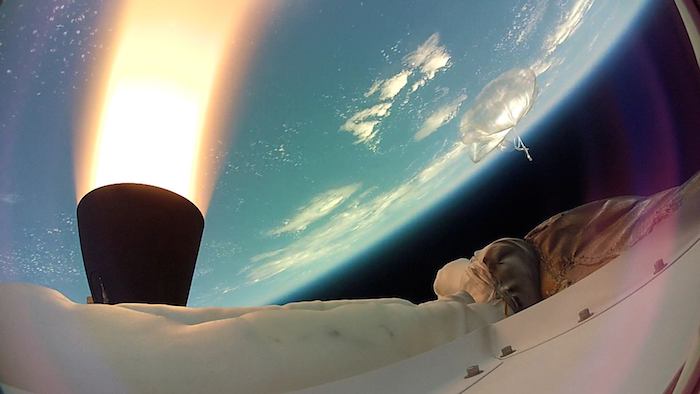
Mars entry testbed to fly Monday after weather delays
.
NASA is gearing up to fly a balloon-launched, rocket-powered test vehicle from Hawaii on Monday to wring out the design of a new supersonic parachute and entry probe scientists hope to use on Mars one day.
Monday’s flight from the U.S. Navy’s Pacific Missile Range in Kauai, Hawaii, is the second in a series of at three test launches into Earth’s upper atmosphere to demonstrate an inflatable braking device and a larger parachute to enable more ambitious probes to land on Mars.
The Low-Density Supersonic Decelerator program is projected to cost $230 million.
Once the tests are complete, officials say the entry systems will allow heavier spacecraft to reach Mars. The technologies are vital to future human expeditions and plans to return Martian soil samples to Earth, NASA officials said.
The 3.4-ton vehicle will take off suspended under a giant helium-inflated balloon and rise to an altitude of 120,000 feet over the Pacific Ocean offshore Kauai. The balloon’s ascent is expected to take up to two-and-a-half hours.
Monday’s flight window opens at 1:30 p.m. EDT (1730 GMT), or 7:30 a.m. local time in Hawaii. Unfavorable wind and sea conditions have kept the flight grounded since its launch window opened June 2.
Resembling a flying saucer, the testbed spans more than 15 feet across and is shaped to mimic the layout of a real Mars-bound spacecraft. The balloon used to loft the demonstrator will stretch 460 feet in diameter once it reaches 120,000 feet, where the test vehicle will release.
After the drop, the vehicle will fire small rocket thrusters to spin up for stability, then a more powerful solid-fueled Star 48 rocket motor built by Orbital ATK will ignite for a 66-second burn to climb to a peak altitude of 180,000 feet — about 34 miles — and a velocity four times the speed of sound.
The rarefied air at that height is a good analog for Mars, which has an atmosphere much thinner than Earth’s.
The SIAD will slow down the craft from three times the speed of sound to Mach 2.35, a velocity engineers say is safe enough to permit deployment of a huge 100-foot-wide supersonic parachute.
“Once we’re going Mach 4 at 180,000 feet, we can deploy the devices, observe their operation and test them,” said Mark Adler, project manager for the Low-Density Supersonic Decelerator at NASA’s Jet Propulsion Laboratory. “It’s going roughly horizontally to give us a lot of time at condition, and then we then slow the vehicle down on the SIAD, then on the parachute.”
If all goes according to plan, the parachute will slow down the demonstrator before it splashes down in the Pacific Ocean northwest of Kauai for retrieval by recovery teams.
Monday’s flight will be the second time NASA has tried out the new entry vehicle.
A different vehicle was recovered intact following a test flight in June 2014, despite problems unfurling the craft’s parachute.
“We learned a great deal from last year’s flight test and used that knowledge to improve the design and manufacturing of the hardware to enhance its strength and performance,” said Steve Jurczyk, head of NASA’s space technology mission directorate. “So this year I’m cautiously optimistic that we’ll have a fully successful flight test, but either way we’re going to gain a tremendous amount of knowledge.”
.

High-speed cameras aboard the LDSD test flight last year recorded detailed imagery of the shredding of the test craft’s parachute. Credit: NASA/JPL-Caltech
The supersonic parachute flown last year ripped apart after it shot out of its holding canister, and high-speed cameras mounted to the craft captured detailed imagery of the chute’s behavior after deployment.
“We saw things that we’d never seen or imagined existed before,” said Ian Clark, the entry system’s principal investigator from JPL. “We saw a much more dynamic and much more turbulent parachute inflation than we thought we had ever known. We saw things like the suspension lines exploding like lightning and moving in a very chaotic manner all over the place.”
Clark said data from NASA’s last supersonic parachute tests in the 1970s was trumped by the high-resolution imagery recorded last year.
“We start to glean a much better understanding of the physical processes that govern and dominate how these parachutes behave under these 2,000 mph winds,” Clark said. “We have made a number of improvements to our parachute. We got all this data, and we’ve improved our understanding, by an order of magnitude, of supersonic parachutes, so we’ve got a new parachute that we’re testing this year.”
Engineers changed the curvature of the parachute to withstand more loads when it unfurls, and NASA added more high-strength material to beef up the crown of the chute, Clark said.
“We’ve got a lot of damage-tolerant capability such that if part of the fabric begins to tear, it won’t propagate through the rest of the parachute,” Clark told reporters in a June 1 briefing. “Overall, it’s a much stronger, much more robust parachute that we think is going to provide another tremendous dataset for us and perform very well for us under these conditions.”
The inflatable segment of the testbed worked as expected last year, and that system is already qualified to fly at Mars, according to Adler.
Another similar flight is scheduled from Hawaii in 2016 to finish testing of the new Mars entry technologies.
.
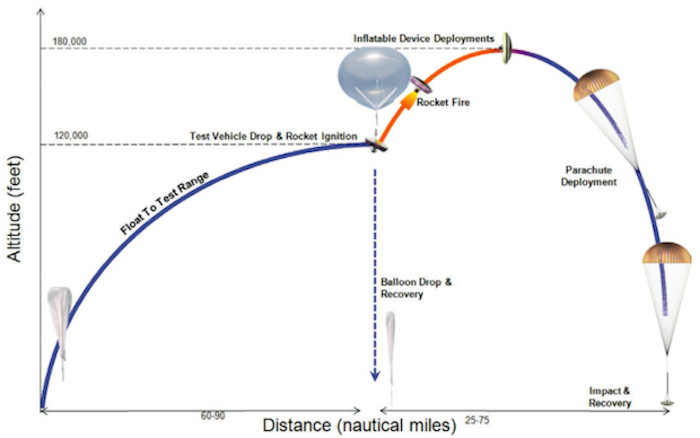
Diagram of Monday’s flight profile. Credit: NASA/JPL-Caltech
NASA’s Curiosity rover and a planned Mars rover set for launch in 2020 rely on parachutes originally developed for the Viking program, which put two landers on the red planet’s surface in 1976.
“Even before we landed Curiosity, we started to realize that the technologies that we had to land robotic missions to the surface of Mars were essentially saturated,” Clark said. “As we started thinking about the next generation of more capable, more exciting, more bold missions to Mars, we started realizing that we didn’t have the technologies in place to land them, and we had to start today to start developing those technologies — things like inflatable drag devices that we can inflate at several times the speed of sound and a new supersonic parachute 100 feet in diameter.
“Those are the technologies that LDSD is developing to enable those future generations of Mars missions that will allow more mass to the surface of Mars and will also allow us to access more of the surface of Mars that we haven’t had available to us in the past,” Clark said.
The Viking-era chutes limit missions to the Martian surface to 1.5 metric tons — about 3,300 pounds — and low-altitude regions to give landers more atmosphere to descend through under parachute, allowing more time to decelerate to a gentle touchdown velocity.
NASA says the experimental descent devices being tested over Hawaii will allow mission designers to double the mass of future landers to basin regions of Mars, and shave the margin-of-error from 6 miles to 2 miles.
A Curiosity-sized rover could reach mountainous parts of the red planet with the new parachute and doughtnut-shaped decelerator, Clark said.
“There’s no guarantee that these tests will be completely successful,” Jurczyk said. “That’s why we go and fly. They’re flight experiments.”
NASA is working on an even larger inflatable drag device to help place heftier payloads on Mars. Jurczyk said human missions to Mars may need to land with up to 30 metric tons, or 66,000 pounds, of cargo and equipment.
“NASA could be really to use this technology in future landed Mars missions as early as the 2020s, and it could be especially beneficial for missions like Mars sample return and for human exploration precursor missions,” Jurczyk said.
Quelle: SN
...
Update: 20.00 MESZ
.
LDSD is Preparing for Launch
The Low-Density Supersonic Decelerators project has been proceeding toward launch since the early morning hours at the U.S. Navy Pacific Missile Range Facility in Kauai, Hawaii. The large scientific balloon – 34.4 million cubic feet in volume, has been undoing inflation over the last hour. When launched, the balloon and the test vehicle stand at a towering 980 feet tall.
.

LDSD is proceeding toward launch. The large scientific balloon – 34.4 million cubic feet in volume, has been undoing inflation over the last hour. When launched, the balloon and the test vehicle stand at a towering 980 feet tall.
The project is targeting a 7:30 a.m. HST/1:30 p.m. EDT launch. Live commentary will begin on NASA Television and JPL’s Ustream channel at 7 a.m. HST/1 p.m. EDT.
---
LDSD Lifts Off!
.
The large scientific balloon carrying Low-Density Supersonic Decelerators test vehicle lifted off from the U.S. Navy Pacific Missile Range Facility in Kauai, Hawaii, at 7:45 a.m. HST/1: 45 p.m. EDT. The balloon will take approximately three hours to reach its float altitude of 120,000 feet.
.

...
LIVE-Update: 20.15 MESZ
.



...
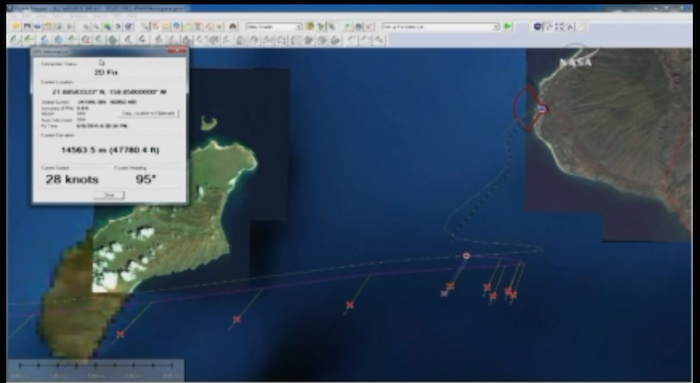


...



...


...
Update: 22.00 MESZ



...



...
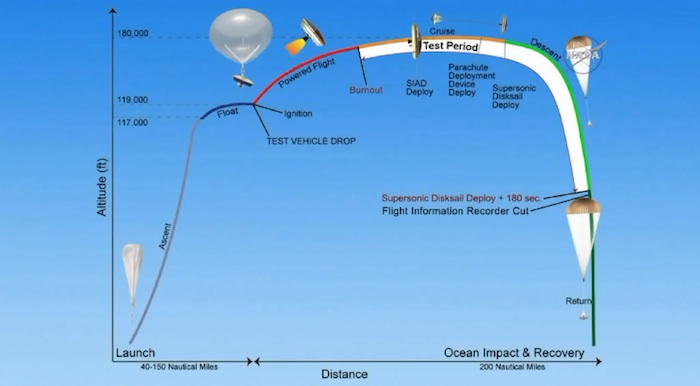



Bordkamera

...
Update: 23.40 MESZ
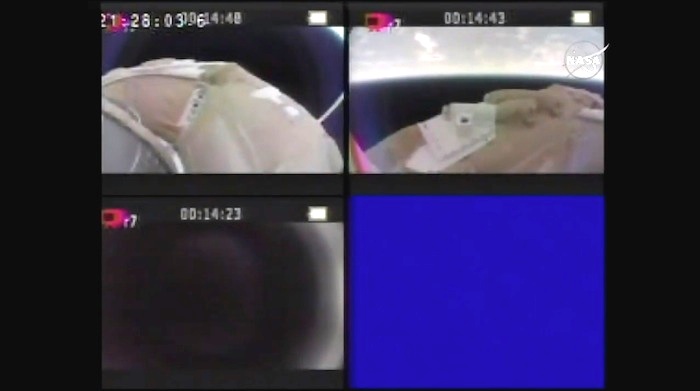









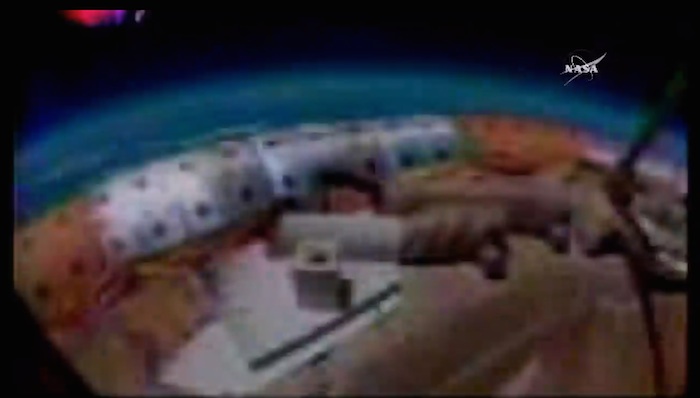

Quelle: NASA
4403 Views
